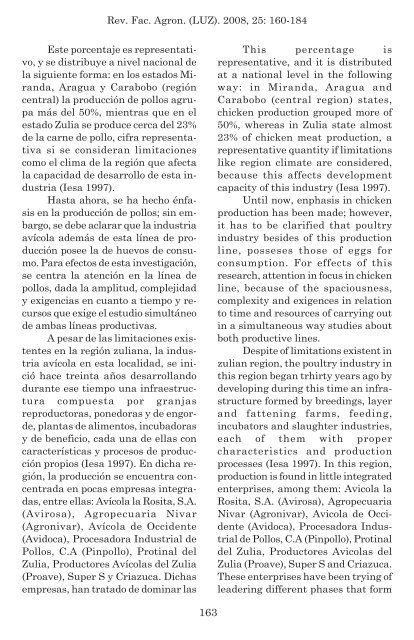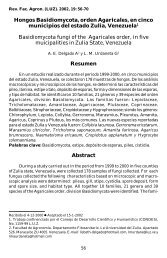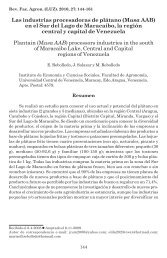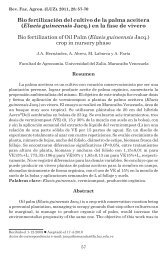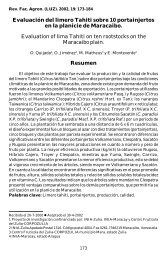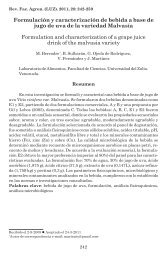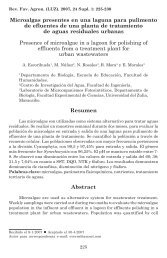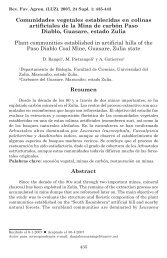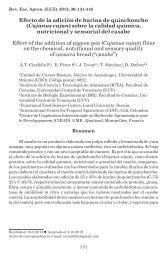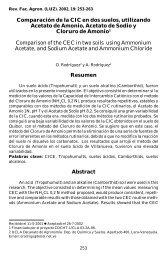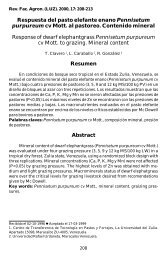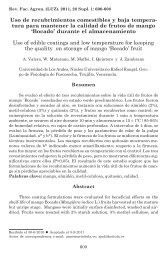Procesos productivos de la industria avÃcola zuliana - Revista de la ...
Procesos productivos de la industria avÃcola zuliana - Revista de la ...
Procesos productivos de la industria avÃcola zuliana - Revista de la ...
Create successful ePaper yourself
Turn your PDF publications into a flip-book with our unique Google optimized e-Paper software.
Rev. Fac. Agron. (LUZ). 2008, 25: 160-184<br />
Este porcentaje es representativo,<br />
y se distribuye a nivel nacional <strong>de</strong><br />
<strong>la</strong> siguiente forma: en los estados Miranda,<br />
Aragua y Carabobo (región<br />
central) <strong>la</strong> producción <strong>de</strong> pollos agrupa<br />
más <strong>de</strong>l 50%, mientras que en el<br />
estado Zulia se produce cerca <strong>de</strong>l 23%<br />
<strong>de</strong> <strong>la</strong> carne <strong>de</strong> pollo, cifra representativa<br />
si se consi<strong>de</strong>ran limitaciones<br />
como el clima <strong>de</strong> <strong>la</strong> región que afecta<br />
<strong>la</strong> capacidad <strong>de</strong> <strong>de</strong>sarrollo <strong>de</strong> esta <strong>industria</strong><br />
(Iesa 1997).<br />
Hasta ahora, se ha hecho énfasis<br />
en <strong>la</strong> producción <strong>de</strong> pollos; sin embargo,<br />
se <strong>de</strong>be ac<strong>la</strong>rar que <strong>la</strong> <strong>industria</strong><br />
avíco<strong>la</strong> a<strong>de</strong>más <strong>de</strong> esta línea <strong>de</strong> producción<br />
posee <strong>la</strong> <strong>de</strong> huevos <strong>de</strong> consumo.<br />
Para efectos <strong>de</strong> esta investigación,<br />
se centra <strong>la</strong> atención en <strong>la</strong> línea <strong>de</strong><br />
pollos, dada <strong>la</strong> amplitud, complejidad<br />
y exigencias en cuanto a tiempo y recursos<br />
que exige el estudio simultáneo<br />
<strong>de</strong> ambas líneas productivas.<br />
A pesar <strong>de</strong> <strong>la</strong>s limitaciones existentes<br />
en <strong>la</strong> región <strong>zuliana</strong>, <strong>la</strong> <strong>industria</strong><br />
avíco<strong>la</strong> en esta localidad, se inició<br />
hace treinta años <strong>de</strong>sarrol<strong>la</strong>ndo<br />
durante ese tiempo una infraestructura<br />
compuesta por granjas<br />
reproductoras, ponedoras y <strong>de</strong> engor<strong>de</strong>,<br />
p<strong>la</strong>ntas <strong>de</strong> alimentos, incubadoras<br />
y <strong>de</strong> beneficio, cada una <strong>de</strong> el<strong>la</strong>s con<br />
características y procesos <strong>de</strong> producción<br />
propios (Iesa 1997). En dicha región,<br />
<strong>la</strong> producción se encuentra concentrada<br />
en pocas empresas integradas,<br />
entre el<strong>la</strong>s: Avíco<strong>la</strong> <strong>la</strong> Rosita, S.A.<br />
(Avirosa), Agropecuaria Nivar<br />
(Agronivar), Avíco<strong>la</strong> <strong>de</strong> Occi<strong>de</strong>nte<br />
(Avidoca), Procesadora Industrial <strong>de</strong><br />
Pollos, C.A (Pinpollo), Protinal <strong>de</strong>l<br />
Zulia, Productores Avíco<strong>la</strong>s <strong>de</strong>l Zulia<br />
(Proave), Super S y Criazuca. Dichas<br />
empresas, han tratado <strong>de</strong> dominar <strong>la</strong>s<br />
This percentage is<br />
representative, and it is distributed<br />
at a national level in the following<br />
way: in Miranda, Aragua and<br />
Carabobo (central region) states,<br />
chicken production grouped more of<br />
50%, whereas in Zulia state almost<br />
23% of chicken meat production, a<br />
representative quantity if limitations<br />
like region climate are consi<strong>de</strong>red,<br />
because this affects <strong>de</strong>velopment<br />
capacity of this industry (Iesa 1997).<br />
Until now, enphasis in chicken<br />
production has been ma<strong>de</strong>; however,<br />
it has to be c<strong>la</strong>rified that poultry<br />
industry besi<strong>de</strong>s of this production<br />
line, posseses those of eggs for<br />
consumption. For effects of this<br />
research, attention in focus in chicken<br />
line, because of the spaciousness,<br />
complexity and exigences in re<strong>la</strong>tion<br />
to time and resources of carrying out<br />
in a simultaneous way studies about<br />
both productive lines.<br />
Despite of limitations existent in<br />
zulian region, the poultry industry in<br />
this region began trhirty years ago by<br />
<strong>de</strong>veloping during this time an infrastructure<br />
formed by breedings, <strong>la</strong>yer<br />
and fattening farms, feeding,<br />
incubators and s<strong>la</strong>ughter industries,<br />
each of them with proper<br />
characteristics and production<br />
processes (Iesa 1997). In this region,<br />
production is found in little integrated<br />
enterprises, among them: Avico<strong>la</strong> <strong>la</strong><br />
Rosita, S.A. (Avirosa), Agropecuaria<br />
Nivar (Agronivar), Avico<strong>la</strong> <strong>de</strong> Occi<strong>de</strong>nte<br />
(Avidoca), Procesadora Industrial<br />
<strong>de</strong> Pollos, C.A (Pinpollo), Protinal<br />
<strong>de</strong>l Zulia, Productores Avico<strong>la</strong>s <strong>de</strong>l<br />
Zulia (Proave), Super S and Criazuca.<br />
These enterprises have been trying of<br />
lea<strong>de</strong>ring different phases that form<br />
163


